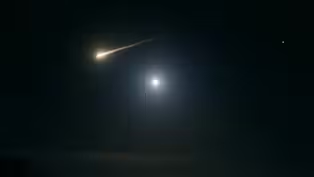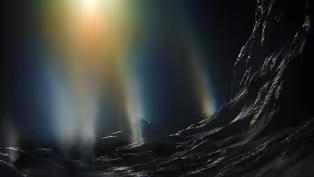
Could Mars Have a Ring Around It One Day?
Clip: Season 51 Episode 13 | 2m 16sVideo has Closed Captions
The moon Phobos has a mysterious origin but a certain expiration date.
Phobos, one of Mars' moons, has an uncertain origin, but its surface grooves show that tidal forces are pulling it apart. In time, Mars' gravity will shatter it entirely, creating a ring of debris around the planet.
Problems playing video? | Closed Captioning Feedback
Problems playing video? | Closed Captioning Feedback
National Corporate funding for NOVA is provided by Carlisle Companies and Viking Cruises. Major funding for NOVA is provided by the NOVA Science Trust, the Corporation for Public Broadcasting, and PBS viewers.

Could Mars Have a Ring Around It One Day?
Clip: Season 51 Episode 13 | 2m 16sVideo has Closed Captions
Phobos, one of Mars' moons, has an uncertain origin, but its surface grooves show that tidal forces are pulling it apart. In time, Mars' gravity will shatter it entirely, creating a ring of debris around the planet.
Problems playing video? | Closed Captioning Feedback
How to Watch NOVA
NOVA is available to stream on pbs.org and the free PBS App, available on iPhone, Apple TV, Android TV, Android smartphones, Amazon Fire TV, Amazon Fire Tablet, Roku, Samsung Smart TV, and Vizio.
Buy Now

NOVA Labs
NOVA Labs is a free digital platform that engages teens and lifelong learners in games and interactives that foster authentic scientific exploration. Participants take part in real-world investigations by visualizing, analyzing, and playing with the same data that scientists use.Providing Support for PBS.org
Learn Moreabout PBS online sponsorship- Phobos orbits Mars in an almost perfect circle, right along Mars's equator.
And this makes us question whether Phobos is really the asteroid it appears to be because captured asteroids usually orbit planets on very elliptical orbits that sometimes take them very far from their planet and sometimes being much closer.
- [Narrator] So if it's not an asteroid, where did this funny little moon come from?
- So in planetary science, the joke is that you just add an impact event, and an impact event can explain everything.
That might actually be true in this case, though, it's this one-off event, and it might have been that an object hit Mars and Phobos is the result of that impact collision between those objects, and that's what we're seeing.
- [Narrator] Phobos may not be a captured asteroid at all, but formed from debris thrown into orbit after a massive asteroid impact.
However, this still doesn't explain why it's covered in grooves.
Phobos is about 3,700 miles from Mars's surface, and every 100 years, moves closer by about six feet.
And as it does, the tidal forces caused by Mars's gravity becomes stronger.
- So just like the moon pulls on the Earth, dragging the oceans and causing the tide, Mars pulls on Phobos, causing tides as well.
So as you can see behind me right now, the tide is coming in as the moon is pulling on the water on the Earth.
The same process happens on Phobos due to Mars, except on Phobos, it's sand and rock that's moving instead of water.
- [Narrator] Those tidal forces are pulling Phobos apart, and with every orbit, the grooves widen and deepen.
Eventually, Phobos will drift so close, Mars's gravity will destroy it.
As Phobos breaks apart, most of the debris will fall to the surface of Mars, but the rest will remain in close orbit, spreading out to encircle the entire planet.
Giving Mars a wispy ring.
(soft atmospheric music)
Cameras Capture Earthbound Meteorite
Video has Closed Captions
Clip: S51 Ep13 | 1m 39s | Some large meteorites survive their descent through our atmosphere and land on Earth. (1m 39s)
Solar System: Wandering Worlds Preview
Video has Closed Captions
Preview: S51 Ep13 | 30s | Meet the surprising, oddball worlds moving around our solar system. (30s)
Providing Support for PBS.org
Learn Moreabout PBS online sponsorship
- Science and Nature

Capturing the splendor of the natural world, from the African plains to the Antarctic ice.













Support for PBS provided by:
National Corporate funding for NOVA is provided by Carlisle Companies and Viking Cruises. Major funding for NOVA is provided by the NOVA Science Trust, the Corporation for Public Broadcasting, and PBS viewers.




